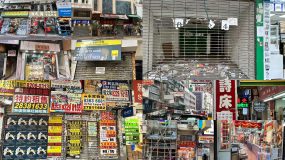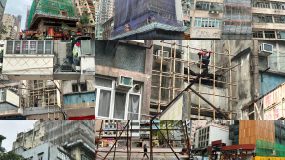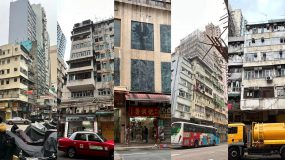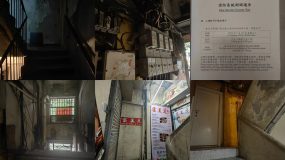T: Hello, everyone. Welcome to our podcast. I’m Tony.
C: I’m Cherry.
T: In this fieldwork podcast, we will explore the vanishing building “Tang Lau”. We will be talking about its definition, history, the reason why it is vanishing, people concerned, and also some measures to deal with it. Cherry, could you please introduce Tong Lau to us briefly?
C: Sure. Tong Lau are tenement buildings in Hong Kong built from the late 19th century to the 1960s, featuring a unique combination of Southern Chinese and European architectural styles. According to the Public Health and Buildings Ordinance, Tong Lau are defined as domestic buildings used for habitation by multiple tenants.
T: So why do people wanna tenant Tong Lau? In other words, what purpose does Tong Lau serve?
C: Tong Lau is designed for both residential and commercial purposes. Tong Lau usually has 4 to 8 floors. The upper floors are for residential use, while the ground floors serve as retail spaces. There are various stores on the ground floors, ranging from grocery stores to local small restaurants, as shown in the picture.
T: Could you tell me more about its past and present?
C: Of course. Tong Lau buildings originated during the Victorian period to house immigrant labours. After WWII, the housing shortage led to the surge of Tong Lau. However, after the 1960s, many Tong Lau were demolished to make way for taller apartments and commercial buildings. Thus, fewer Tong Lau remain in Hong Kong today.
T: You mentioned that fewer Tong Lau are found in Hong Kong today. Then why is Tong Lau vanishing? How do we know that it will no longer exist in the near future?
C: Well, Tong Lau buildings have been demolished due to urban development, as they were considered to have lower economic value and less population capacity compared to modern high-rises. Additionally, government policies favouring high-rise buildings over historical structures have also contributed to their demolition. Moreover, Tong Lau buildings are old and struggle to meet modern building standards. The collapse of one in 2010 at 45 Ma Tau Wai Road highlights this issue. Their aging infrastructure is incompatible with modern lifestyles, and the renovating cost is often too high, making Tong Lau vulnerable to demolition.
T: What a pity! The demolition of Tong Lau, a vessel of memories of old Hong Kong residents, means a significant loss of Hong Kong’s history and character.
C: Yeah, but it’s happening because the city is growing and changing. Okay, as we witness the gradual disappearance of Tong Lau, it’s important to turn our attention to the people influenced by these changes. I’ve been thinking about who will be affected by this. Do you have any insights?
T: Absolutely. One group that will be significantly affected are the retailers who operate in the small spaces beneath the staircase. They provide essential services like watch repair, haircutting, and selling snacks or trinkets. With the removal of Tong Lau, they may be worried because they will possibly lose their jobs and livelihoods.
C: That’s a valid point. It’s unfortunate that the removal of Tong Lau will lead to unemployment for these small businesses. What about the residents living in Tong Lau? How will they be affected?
T: The residents will face the challenge of finding new homes and bearing the burden of moving. It can be quite a daunting task, especially considering the crowded living spaces in Tong Lau. The demolition will disrupt their lives and create a sense of loss within the neighbourhood. So many of them aren’t satisfied with the demolishment, but some residents may feel a mix of nostalgia and anticipation for potential improvements.
C: I’m really sorry to hear that. It must be a difficult situation for them. What about others?
T: The landlords of Tong Lau buildings will be impacted as they have rented out the apartments to different families. With the disappearance of Tong Lau, they may be worried because they will need to make alternative arrangements for their properties. Furthermore, visitors will no longer be able to appreciate the architectural charm and cultural heritage that these buildings offer. They may view it as diminishing the city’s architectural and historical uniqueness.
C: What a huge influence! On a more positive note, what is being done to address th0065 impending disappearance?
T: Efforts have been made by the government and authorities to preserve Tong Lau buildings over the past 20 years. They have undertaken projects to safeguard and restore some of these buildings. Additionally, individuals like Sam Ma Hung-Choi, who transformed a Tong Lau into a cafe, and businesswoman Ho, who established a foundation, are actively working towards preserving the buildings and neighbourhoods.
C: It’s encouraging to see both government and individual initiatives in place. But are there any challenges that need to be addressed?
T: Yeah, there are many challenges. One major challenge is the insufficient financial subsidy provided by the government. The cost of preserving these old buildings is high, and the current grant offered by the government is far from enough to fully refurbish the buildings.
C: That’s a significant hurdle to overcome. Are there any other obstacles?
T: Absolutely. Administrative procedures can pose a challenge to the owners. They often need to apply multiple times for approval to repair their properties, which can be a time-consuming and complex process.
C: I see. So, there are challenges in terms of financial support and administrative procedures. If these challenges persist, what do you think will happen to Tong Lau buildings in the future?
T: If these challenges are not adequately addressed, Tong Lau buildings are likely to vanish in the future. It would be a tremendous loss for the community and the cultural heritage of Hong Kong.
C: I completely agree. All stakeholders must work together to find ways to preserve Tong Lau, balancing their conservation with urban development. This balance is vital for sustainable urban landscapes and modern society’s evolving needs.
5 stills:





Shao Boning (3036127373, Tony)
Wang Zhiyu (3036129113, Cherry)